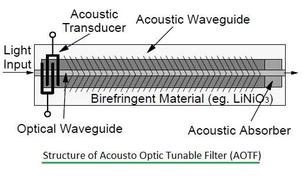Dichroic Filter: Definition and Functionality
Advertisement
This page explains the basics of a Dichroic filter and its function, particularly in a fiber optic network context. We’ll start with a quick recap of WDM (Wavelength Division Multiplexing).
WDM is a multiplexing technique that combines optical signals of different wavelengths.
Generally, a “filter” refers to a device that allows some frequencies to pass through while blocking or rejecting others. Common types include Low Pass Filters, High Pass Filters, Band Pass Filters, and Band Stop Filters.

Just as frequency-based filters operate on different frequencies, a Dichroic filter operates on different wavelengths of light. It’s a very precise color filter.
Function of a Dichroic Filter
A Dichroic filter passes light within a specific wavelength range and reflects light in another wavelength range. Its selective wavelength manipulation makes it particularly useful in WDM networks.
In WDM systems, Dichroic filters are used to combine (multiplex) and separate (demultiplex) different wavelengths of light, enabling the transmission of multiple data channels over a single optical fiber.
Advertisement
 RF
RF

